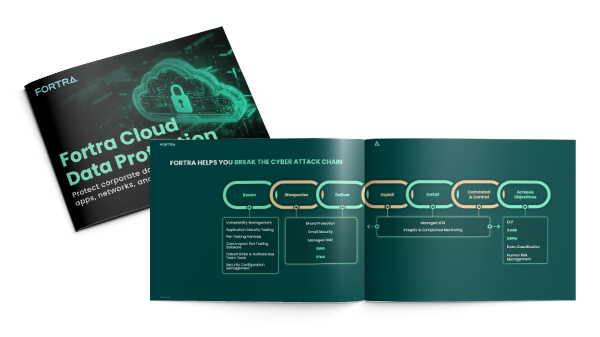
In the same way an organization takes care of its employees, customers, and finances, it also needs to ensure its sensitive data is well protected. For comprehensive data security, organizations need to add a layer of protection so that each stage of data is protected throughout its journey for end-to-end security.
Ideally, your data protection strategy should include solutions that can understand and classify your data, detect and prevent leaks, and secure and protect data both at rest and in motion.
People, process, and technology all play a key role. To reduce risk and meet data protection and privacy regulations, safeguarding methods need to include a combination of access, security, and organizational controls. Access to sensitive data needs to be restricted both physically and online. Systems, networks, and applications need the appropriate administrative and security controls, and employees need policies that allow them to understand and implement industry best practices.
What is Data Protection?
Data protection is the process of safeguarding important information from theft or loss. These actions can be malicious or unintentional, but a robust data protection program will protect against both.
A large part of data protection is ensuring that data is accessible for authorized purposes only, as well as being compliant with necessary regulatory requirements.
Every day the data that businesses are creating and storing is growing. With hybrid work environments making remote collaboration a reality of daily business, and companies choosing to migrate technology to the cloud for both cost-saving and efficiency purposes, enterprise data protection is more important than ever to protect data regardless of where it is or how it is used.
Data protection programs can be primarily focused on two broad uses—ensuring protection and auditing of regulated data such as PCI, PII, or PHI, or protecting the intellectual property organizations rely upon to expand their business. Any program must balance the needs of protection with the risks of sharing. Overly aggressive programs can stifle business processes, while overly lenient programs can lead to excessive risk.
Data Protection vs. Data Security
The terms data protection and data security are often used interchangeably, and while there are similarities,
there are also important differences between the two.
Data Protection
Data Security
What is Data Privacy?

Data privacy, at its most basic, is defined as the appropriate use of data. When data is entrusted to an organization, it is to be used only according to the purposes agreed upon.
Data privacy and protection laws are becoming increasingly more commonplace across the US, with different states introducing new regulations. Ensuring data privacy is prioritized at your organization can help prevent misuse that can result in substantial financial and reputational costs.
Incorporating data protection solutions enterprise-wide can provide the layered security needed to ensure data privacy and protection policies enacted can be carried out.
Data Security and Data Privacy
What Is Data Privacy Important?
Data Protection Solutions from Fortra
Organizations rely on sensitive data to serve their customers, fuel innovation, and grow. Security leaders need a way to find and understand that data, then protect it from loss or theft while within their extended enterprise and securely share it outside of their extended enterprise.
Fortra's leading data protection offering delivers interlocking security for all cybersecurity maturity levels. Our modular solutions combine to address your immediate needs and use cases, as well as advise your next best steps as your security program evolves.
Data Loss Prevention
Fortra DLP deploys and starts fast to give you immediate visibility into your data security, intuitive results in out-of-the-box dashboards, and greater deployed efficacy. From discovery to monitoring to blocking, comprehensive data loss prevention capabilities help support compliance initiatives and protect against serious risk while guiding users on the next-best security step. SaaS and managed service deployment options help deliver results faster and give you the expertise you need.
Data Classification
Fortra Data Classification solutions enhance data security by applying visual and metadata labels so you can best support DLP policies. AI engine recommendations help reduce business friction by guiding which label is best to apply, and employees receive real-world security training that drives visibility and engagement with data security practices across the organization.
CASB
Cloud Access Security Broker (CASB) acts like a security guard for cloud applications, positioned between your employees and the cloud apps they use. Fortra monitors cloud activity and keeps data safe by making sure the right people have access to the right data, stopping risky behavior, and monitoring unsanctioned cloud app usage so employees don’t use unsafe tools.
DSPM
Fortra Data Security Posture Management (DSPM) serves as a security system for your company’s cloud data, protecting commonly used applications like Google Drive, AWS, and Microsoft Azure. Understand where all your data lives, what kind of data it is (sensitive or not), who has access to it, and whether it's being protected properly.
SWG
Fortra Secure Web Gateway (SWG) protects users, networks, and corporate data from internet-based threats like malware, zero-day, and browser-based attacks. It inspects all incoming and outgoing web traffic for malicious content and sensitive information.
ZTNA
Fortra Zero Trust Network Access (ZTNA) provides secure remote access to all private applications and protects the data stored within them. Grounded on the principles of zero trust and least privilege access, users only receive access to private apps they need to get their job done, preventing lateral network movement in real time.
Cloud Data Protection
What Is Cloud Data Protection?
Cloud data protection uses tools and techniques to protect data being used by software-as-a-service (SaaS) and private applications, data in transit between cloud services or otherwise in motion, and data stored in cloud repositories.
Why Prioritize Data Protection in the Cloud?
Data protection within cloud environments is becoming a critical challenge to overcome as organizations increasingly transfer their data to the cloud, be it a simple public or private cloud repository, to more complex architectures such as a hybrid cloud, multi-cloud, and SaaS platform. While these kinds of cloud tools and services deliver several business benefits, including facilitated employee collaboration, simplified remote data access, and enhanced user productivity in general, they also introduce several data protection complexities that leave organizations vulnerable to accidental data breaches, insider threats, and attacks from external threat actors.

The Challenges
Organizations' increasing utilization of the cloud, in combination with the ever-changing requirements posed by compliance regulations and the complex nature of cloud architectures, creates a myriad of data protection challenges, including:
- Lack of Visibility: Organizations commonly struggle to keep an accurate inventory of all cloud applications and data.
- Unsecured Access: Third-party hosted applications typically provide fewer controls than on-premises applications, making it more difficult to have full visibility of user activity and how sensitive data is being used.
- Lack of Control: There is often an implicit "shared responsibility" between cloud vendors and customers to manage their SaaS cloud tools, meaning users gain control over some aspects of their security, but others remain within the scope of the vendor and outside of the customers' control.
- Security Feature Discrepancies: Cloud tools and platforms often deliver limited (if any) built-in data protection capabilities, which can lead to inconsistent, tedious-to-manage cloud security.
The Solution
In an increasingly cloud-driven landscape, the perimeter-based security models of the past are now far less effective in protecting organizations' most sensitive data. For comprehensive protection, organizations now must take a zero-trust approach to security and extend the known benefits of endpoint security to the cloud. Fortra's Cloud Data Protection products—CASB, DSPM, SWG, and ZTNA—combine with DLP and Data Classification combine for a data-centric approach to data protection that extends to your entire cloud environment.
The Ultimate Guide to Data Protection
Protecting data is paramount to business success. Download this guide to learn what data protection is, why it's so critical, and how businesses can better protect the data they store and process.